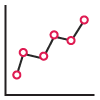Lean Portfolio Management Blog Series Part 4: Tooling
In the previous articles in this series, we’ve discussed the dangers of “imitation” lean portfolio management (LPM), the steps required to set up effective LPM in your organization, and the importance of connecting all levels of the organization, so there are no gaps in your data. In this fourth and final article, we want to introduce you to a tool that can help you put all these principles into action.
The most common challenges preventing organizations from fully embracing effective LPM fall into three main categories:
- Lack of alignment – various levels of the organization are disjointed, unable to move forward efficiently toward established goals, or unable to communicate strategy effectively.
- Lack of predictability – with disjointed teams working without effective alignment and significant gaps in the data needed to guide them, releases become more complex and unwieldy, and KPIs are routinely compromised in favor of checking off completed tasks.
- Lack of governance – metrics, reporting and monitoring are poorly controlled and slow to affect action, sacrificing agility in favor of bureaucracy.
The organization can rectify these challenges through an overarching management platform that takes a top-down approach to monitoring and managing widespread development teams and offers the necessary flowthrough to connect top-level strategy to day-to-day activity.
Many solutions on the market offer some or all of the tools necessary to get this job done. Rally, TFS, VersionOne, and various alternatives can be configured to support effective LPM with varying levels of complexity and effort. And, if that’s what you’re already using, we can certainly help you make it work. However, the solution set we’ve seen the most success with is Atlassian’s Jira Align.
As we run through the following quick overview of LPM in Jira Align, please note that the principles and benefits apply equally to whichever software solution your organization settles on.
What is Jira Align?

Built to align organizations around common goals and objectives, Jira Align provides that overarching platform that starts at the very top — with business goals and strategies — and carries those guidelines down to the individual team level, offering visibility and context to every stakeholder along the way.
The solution can function as that “single source of truth” that feeds the information radiators using semi-automatic throughput of accurate, real-time data that matters. With over 250 reports built-in and custom reporting capabilities, real-time and historic monitoring becomes part of the fabric of the agile organization.
What Features Make Jira Align Perfect for LPM?
Some of the key features that make this possible include:
-
- Strategic Mapping: Jira Align is the only tool in the market that currently supports mapping Strategy Objects to Work Objects. Model your Strategic Hierarchy, connect work to OKRs, and track the accomplishment of both work and strategy over time.
- Value stream Process Step Mapping: Help portfolio managers monitor ongoing work in more effective groupings that center on the produced value. This keeps development teams and release trains running “on schedule” while ensuring they’re working in line with strategic business goals.
- Rooms allow stakeholders at various levels of the organization to access the entire store of reporting and monitoring, geared toward their roles, all in one place.
- Integrations break down barriers between teams who may be using different applications. For larger enterprise organizations seeking unification following a merger or acquisition, this can be especially valuable to get everyone on the same page quickly.
- Slice and Dice Visualizations: Ensure that every stakeholder receives all data they need quickly, accurately, and consistently. View work rollup information by teams and teams of teams through multiple timeboxes, all of your choosing. Unlike ad hoc spreadsheets prepared differently by every division manager, one centralized database provides coherent reporting to every level of the organization.
The following excerpt comes from a separate series of blog posts we previously published regarding Jira Align, which speaks to how the built-in data connectivity and automation power an effective LPM program:
Consolidated data

Within Jira Align, each role has its own dedicated “room” containing the core suite of reports and views that individuals are likely to need most often. For example, in the portfolio manager’s room, we find these vital sources of real-time data and analysis at their fingers:
- Strategic/financial alignment – big picture financial data, viewed through the lens of enterprise strategy
- Demand intake and forecasting – allowing balanced, coordinated intake with what-if analysis for strategic, prioritized decision making
- Investments vs. actuals – the foundation for all strategic budgeting decisions for WIP and future planning
- Value stream optimization – filtering all deliverables, resource allocation, and budgeting data through value streams
- Portfolio agile metrics – consolidated burndown and burnup views with numerous filters to drill down from programs to epics, teams, and individuals.
- Portfolio WIP – constant visibility into where work stands across all programs and products
Additionally, each report or view offers the opportunity to drill down to the program and product levels to offer granular context to every data point and trend on display. And, all users have access to upwards of 250 reports, so even if what they need isn’t already housed in the portfolio room, it’s just a click away.
With this real-time reporting always on hand, portfolio managers never need to make decisions based on gut feelings and guesswork. They can easily spot discrepancies or unexpected bottlenecks at any level and address them quickly to keep the portfolio moving ahead toward success.
Process automation
Automation capabilities further augment the wealth of information available within Jira Align, removing much of the project management busy work from managers’ plates, freeing them up to focus more on strategic analysis and planning.
For example, the portfolio backlog housed in Jira Align utilizes easy drag-and-drop functionality for prioritization. Users can filter the backlog by program, strategic driver, owner, process step, WSJF, story points, or more. Then, as program and product managers further build out the backlog with tasks and work commences, the entire backlog dynamically updates across the whole solution, no matter what view or filter you’re using.
As work progresses and reprioritization of the strategy or initiatives becomes necessary, Jira Align users do not have to go in and manually reorder features accordingly. Instead, they can choose to “Pull Rank” to automatically rearrange features respective to the new priority assigned to the parent item. As a result, everyone always has access to the latest backlog and all the associated data on tasks in progress or already completed.
Dive Deeper
We recommend viewing our webinar series on LPM to dive even deeper into Jira Align and other tooling solutions for effective LPM. The fourth installment will deal exclusively with The Best Tool Ecosystem to Support Lean Portfolio Management.


